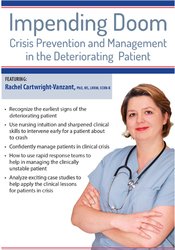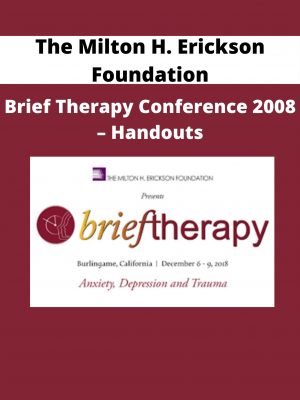Rachel Cartwright-Vanzant – Impending Doom
$219 Original price was: $219.$62Current price is: $62.
Shopping Instructions:
- DISCOUNT 15% : SHOP15
- Product Delivery: Within 1 – 12 hours after purchase.
Available for Pre-Order. This product will be available within a few days.
Rachel Cartwright-Vanzant – Impending Doom
- Recognize the earliest signs of the deteriorating patient
- Use nursing intuition and sharpened clinical skills to intervene early for a patient about to crash
- Confidently manage patients in clinical crisis
- How to use rapid response teams to help in managing the clinically unstable patient
- Analyze exciting case studies to help apply the clinical lessons for patients in crisis
Do you as a nurse/clinician recall a patient who seemed to deteriorate in front of your eyes and wonder if anything could have prevented this clinical crisis?
What do you do with the subtle signs and symptoms you identify in your patient that are yet within normal limits but your nursing intuition tells you that there is something wrong?
How do you learn the early clinical signs of impending doom in the patient and effectively intervene before the crisis occurs?
Ideally, your job is not to run a good code but to prevent the code from ever happening. In order to do that, you have to know what the early warning signs are, perceive them, interpret them within the whole clinical picture, and act for the benefit of the patient.
Subclinical signs – the early first warning signals of a problem – are examined in this workshop. You will leave with a clearer understanding of the body’s complex, interrelated organ systems and be able to break them in to their component parts to understand how one organ system can cause a sign or symptom in another organ system.
Would you like to receive Rachel Cartwright-Vanzant – Impending Doom ?
Today’s nurses care for more patients with higher acuity than ever before. In order to forestall crisis, you have to know who is at risk and recognize the warning signs, however subtle they initially may be in appearance. Hindsight is 20/20. The art and science of nursing, the vital difference in effective nursing, is in the ability to “see it coming”. Rachel Cartwright-Vanzant, PhD, MS, LHRM, CCRN-K, will share with you effective and put-to-the-test strategies to detect clinical changes in the deteriorating patient.
Related products
HEALTH & MEDICAL
HEALTH & MEDICAL
Dr. J.E. Williams & Kevin Gianni – How to Read Your Blood Tests
HEALTH & MEDICAL
HEALTH & MEDICAL
Regina Meredith – Conscious Media Network with Regina Meredith – Eric Pearl on The Reconnection
HEALTH & MEDICAL
Bernadette Giorgi – Attitude Ballet & Pilates Fusion – Just B Method
HEALTH & MEDICAL
Dr Heidi M Crocker – Yoga Alignment | Speaker: Heidi Crocker EdD, DC












